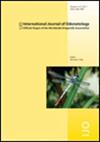Demography and natural history of the damselfly Mesamphiagrion gaudiimontanum (Coenagrionidae), a Páramo endemic species in the Colombian Andes
IF 1
4区 农林科学
Q3 ENTOMOLOGY
引用次数: 0
Abstract
The páramos are high mountain ecosystems in the tropical regions of the New World, and they are particularly threatened by climate change. The Belmira páramo complex in Colombia is home to Mesamphiagrion gaudiimontanum, an endemic and endangered damselfly species. This study presents the first demographic assessment of M. gaudiimontanum using the capture-recapture method to estimate population size, survival, and detection probabilities, focusing on differences in age, sex, female color morphs, and parasite infestation. The population size was estimated to be 730 ± 186.59 individuals, with an average survival probability of 0.89 ± 0.04 and a life expectancy of 8.34 days, these data are like the reported for other populations in the same genus in harsh environmental conditions. Ectoparasitic mites were more common on juveniles than adults. After several hours of observing the species few copula events have been recorded, all of them involving juvenile adult females, which points to a monandrous reproduction syndrome for the species. Another phenomenon observed in the species was a change in coloration due to body temperature in individuals, in which bright coloration becomes grayish in cold weather. This study provides fundamental data for future monitoring and conservation efforts, highlighting the species’ vulnerability to environmental changes and the need for specific conservation strategies.哥伦比亚安第斯山脉帕拉莫地区特有物种豆娘 Mesamphiagrion gaudiimontanum(Coenagrionidae)的繁殖情况和自然史
巴拉莫山是新大陆热带地区的高山生态系统,尤其受到气候变化的威胁。哥伦比亚的贝尔米拉(Belmira)páramo复合生态系统是Mesamphiagrion gaudiimontanum的家园,Mesamphiagrion gaudiimontanum是一种特有的濒危豆娘物种。本研究首次对M. gaudiimontanum进行了人口统计评估,采用捕获-再捕获法估算种群数量、存活率和检测概率,重点关注年龄、性别、雌性颜色形态和寄生虫感染的差异。种群数量估计为 730 ± 186.59 只,平均存活概率为 0.89 ± 0.04,预期寿命为 8.34 天,这些数据与其他同属种群在恶劣环境条件下的数据相同。幼体上的外寄生螨比成体更常见。经过几个小时的观察,该物种的共生现象很少,都是幼年成年雌性共生,这表明该物种存在单性繁殖综合征。在该物种中观察到的另一个现象是个体的体色会因体温而改变,在寒冷的天气里,明亮的体色会变得灰暗。这项研究为今后的监测和保护工作提供了基础数据,凸显了该物种易受环境变化影响的脆弱性以及制定特定保护策略的必要性。
本文章由计算机程序翻译,如有差异,请以英文原文为准。
求助全文
约1分钟内获得全文
求助全文
来源期刊

International Journal of Odonatology
ENTOMOLOGY-
CiteScore
2.30
自引率
0.00%
发文量
15
审稿时长
>12 weeks
期刊介绍:
International Journal of Odonatology (IJO) is aimed at providing a publication outlet for the growing number of students of Odonata. It will address subjects such as the ecology, ethology, physiology, genetics, taxonomy, phylogeny and geographic distribution of species. Reviews will be by invitation, but authors who plan to write a review on a subject of interest to the journal are encouraged to contact the editor.
 求助内容:
求助内容: 应助结果提醒方式:
应助结果提醒方式:


